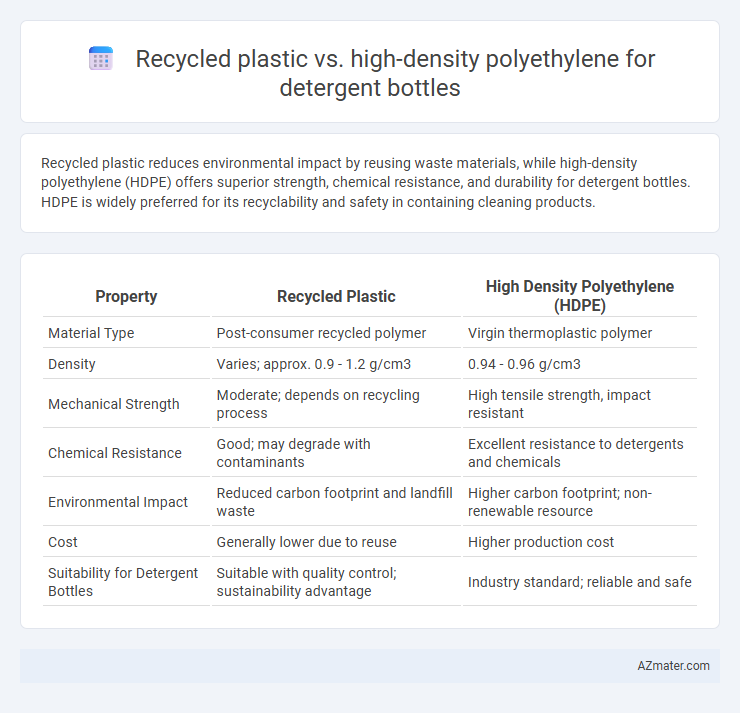Recycled plastic reduces environmental impact by reusing waste materials, while high-density polyethylene (HDPE) offers superior strength, chemical resistance, and durability for detergent bottles. HDPE is widely preferred for its recyclability and safety in containing cleaning products.
Table of Comparison
| Property | Recycled Plastic | High Density Polyethylene (HDPE) |
|---|---|---|
| Material Type | Post-consumer recycled polymer | Virgin thermoplastic polymer |
| Density | Varies; approx. 0.9 - 1.2 g/cm3 | 0.94 - 0.96 g/cm3 |
| Mechanical Strength | Moderate; depends on recycling process | High tensile strength, impact resistant |
| Chemical Resistance | Good; may degrade with contaminants | Excellent resistance to detergents and chemicals |
| Environmental Impact | Reduced carbon footprint and landfill waste | Higher carbon footprint; non-renewable resource |
| Cost | Generally lower due to reuse | Higher production cost |
| Suitability for Detergent Bottles | Suitable with quality control; sustainability advantage | Industry standard; reliable and safe |
Introduction to Detergent Bottle Materials
Detergent bottles are commonly manufactured using high-density polyethylene (HDPE), known for its durability, chemical resistance, and lightweight properties. Recycled plastic offers an eco-friendly alternative, reducing environmental impact by reusing post-consumer HDPE materials while maintaining comparable strength and flexibility. Choosing between virgin HDPE and recycled plastic involves balancing sustainability goals with performance requirements in detergent packaging.
What is Recycled Plastic?
Recycled plastic refers to plastic materials that have been reclaimed and processed from used products or manufacturing waste to create new items, reducing environmental impact. For detergent bottles, recycled plastic often includes materials like post-consumer PET or HDPE, which are cleaned, melted, and remolded to maintain durability and chemical resistance. High density polyethylene (HDPE) is a common type of plastic used in detergent bottles due to its strength, chemical stability, and recyclability, making recycled HDPE a sustainable and effective choice for packaging.
Understanding High Density Polyethylene (HDPE)
High Density Polyethylene (HDPE) is a thermoplastic polymer characterized by its high strength-to-density ratio, making it ideal for detergent bottles due to its durability and resistance to impact and chemicals. Recycled plastic in detergent bottles often incorporates HDPE, which maintains structural integrity and supports environmental sustainability by reducing plastic waste. The versatility and moisture-resistant properties of HDPE ensure long shelf life and effective containment of liquid detergents.
Sustainability and Environmental Impact
Recycled plastic detergent bottles significantly reduce landfill waste and lower carbon emissions by reusing existing materials, promoting a circular economy in packaging. High-density polyethylene (HDPE) offers durability and recyclability but requires substantial energy and raw materials during production, impacting environmental sustainability. Choosing recycled HDPE blends enhances resource efficiency and cuts greenhouse gas emissions, making it a more eco-friendly option for detergent containers.
Durability and Performance Comparison
Recycled plastic detergent bottles often exhibit slightly lower durability compared to high density polyethylene (HDPE) due to potential impurities and variability in resin quality, impacting resistance to impact and chemical exposure. HDPE bottles provide superior performance by maintaining consistent structural integrity, excellent chemical resistance, and flexibility, making them ideal for detergent storage. Performance differences are most notable in long-term storage and rigorous handling, where HDPE's uniform molecular density ensures better retention of bottle shape and strength under stress.
Cost Analysis: Recycled Plastic vs HDPE
Recycled plastic detergent bottles typically offer a cost advantage over high-density polyethylene (HDPE) due to lower raw material expenses and reduced environmental fees. HDPE, while more expensive initially, provides consistent quality and durability, leading to potential savings in packaging performance and product protection. Evaluating total lifecycle costs, recycled plastics may require additional processing that can influence final prices, making cost analysis a balance between material price and manufacturing efficiency.
Packaging Safety and Chemical Resistance
Recycled plastic used for detergent bottles often contains impurities that can compromise packaging safety, leading to potential chemical leaching and reduced barrier properties. High-density polyethylene (HDPE) offers superior chemical resistance and structural integrity, ensuring safer containment of aggressive detergent formulations without degradation over time. HDPE's consistent polymer matrix provides enhanced packaging safety by effectively preventing contamination and maintaining product stability throughout the shelf life.
Consumer Perception and Brand Value
Recycled plastic detergent bottles often appeal to environmentally conscious consumers, enhancing brand value by showcasing a commitment to sustainability and reducing carbon footprint. High-density polyethylene (HDPE) offers durability and chemical resistance, which reassures consumers about product safety and quality, fostering trust in the brand. Brands leveraging recycled plastic may gain competitive advantage by aligning with eco-friendly trends, while HDPE's performance reliability supports long-term consumer confidence.
Regulatory Standards and Compliance
Recycled plastic detergent bottles must comply with stringent FDA and EPA regulations ensuring material safety, non-toxicity, and leachability, particularly for post-consumer recycled content to meet sustainability mandates. High density polyethylene (HDPE) used in detergent bottles often exceeds these regulatory standards due to its inherent chemical resistance, durability, and FDA approval for food-grade applications, making it a preferred material for compliance. Both materials require adherence to REACH and RoHS directives to minimize hazardous substances, with recycled plastic demanding rigorous quality control to maintain consistent compliance levels.
Future Trends in Detergent Bottle Materials
Future trends in detergent bottle materials emphasize the increasing adoption of recycled plastic to reduce environmental impact and promote circular economy practices. High density polyethylene (HDPE) remains a preferred choice due to its durability, chemical resistance, and compatibility with recycling processes, facilitating sustainable packaging solutions. Innovations in bio-based HDPE and advanced recycling technologies are expected to enhance the performance and eco-friendliness of detergent bottles in the coming years.

Infographic: Recycled plastic vs High density polyethylene for Detergent bottle
 azmater.com
azmater.com